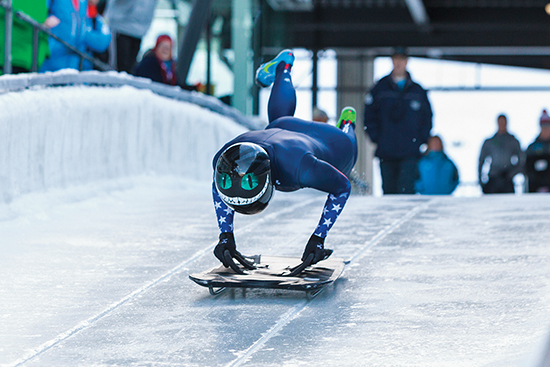
Q&A with Veronica Day
Team USA athlete Veronica Day started out as a track and field star from Vienna. Now, at age 25, she’s ranked 6th in the nation for the winter sport skeleton. Here, Day gives insight on her life as an athlete training for a chance at the Pyeongchang 2018 Olympic Games.
By Bailey Lucero-Carter
How did you begin your transition from track to skeleton?
Senior year I sent an athletic resume to the US Bobsled and Skeleton Federation and got recruited from there. I was too small to do bobsled but skeleton athletes kind of fit into my body type and size. They recruit track and field athletes for the push start at the beginning. … They recently started recruiting athletes who they think can push fast, which is in a downright crouched sprinting position, in hopes that they can teach them how to drive down the road.
Speed is universal. If you’re fast at track you can be fast, most likely, in a crouched position as well, which is why they recruit fast people.
Tell me about your experience as a member of Team USA.
[I]n general it’s kind of humbling to live in the Olympic Training Center and to have all these amazing athletes around you. You might think you’re great one day and then you watch someone in the weight room, or you watch someone sprinting. It’s just impressive and humbling and definitely drives me to get better. And I’m sure it does the same thing for everyone else.
Team USA athlete and Vienna native Veronica Day gives tips for sledding like a pro.
– “Wear lots of layers, especially a waterproof layer. That is the key, the waterproof layer on the outside.”
– “First, if you’re going to go face first, I recommend you wear some kind of a helmet.”
– “[U]se your feet for steering. You can drag your toes and change the direction that the sled’s going in.”
– “If you get nervous, I would say bail and just roll off the sled and the sled will keep going. You’ll just probably lay there. I’ve done that before when I’m doing skeleton. Not deliberately, but it’s happened, probably for the best.”
What’s your training like on an average day?
I work full time, remotely, so that’s always a part of my day. But most of the time during the season I will wake up, eat breakfast and go and sprint—that usually takes about an hour. Then, I’ll go straight into the weight room. That can take two hours or so. I will work then eat lunch. We go and we slide and that takes probably four hours out of the day. We do that Monday through Friday, come back, probably eat dinner and then do some more work. Then go to bed and do it all over again.
What advice do you have for Northern Virginians who want to pursue a winter sport?
If you watch something on the Olympics and think, ‘How the heck did these people get into that sport?,’ look it up online because I guarantee you it’s not that crazy of a story. Just go to TeamUSA.org and look up the sport that you’re interested in. They’ll most likely have the recruitment section in there, and it’ll tell you all about how athletes get recruited into the sport.
Basically, if something you think looks interesting and you want to try it, there are certainly avenues at different Olympic training sites. Chances are, you can take a skeleton run, you can take a bobsled ride, you can go to the speed skating track in Park City and get a lesson from some of the speed skaters there. You can go to the 1980 rink in Lake Placid and do curling or something like that.
There are avenues. You’ve just got to be curious enough to investigate.
(January 2015)
